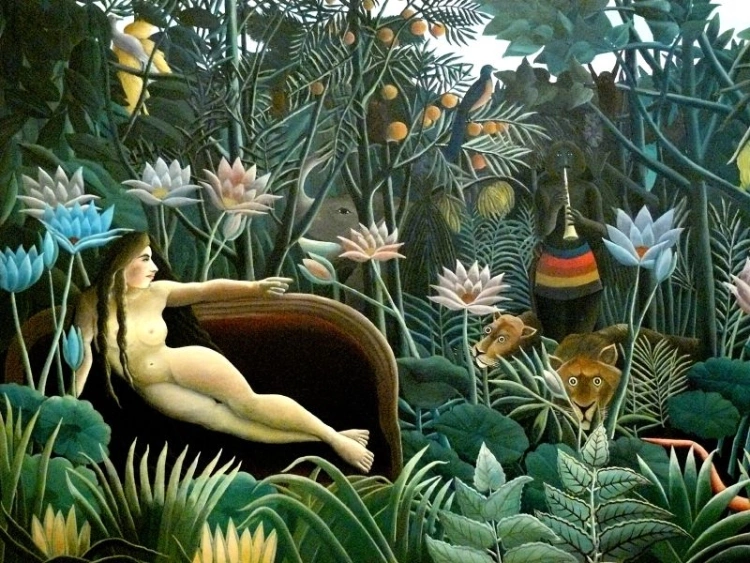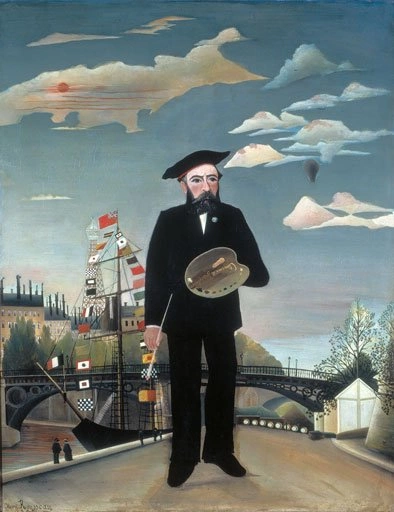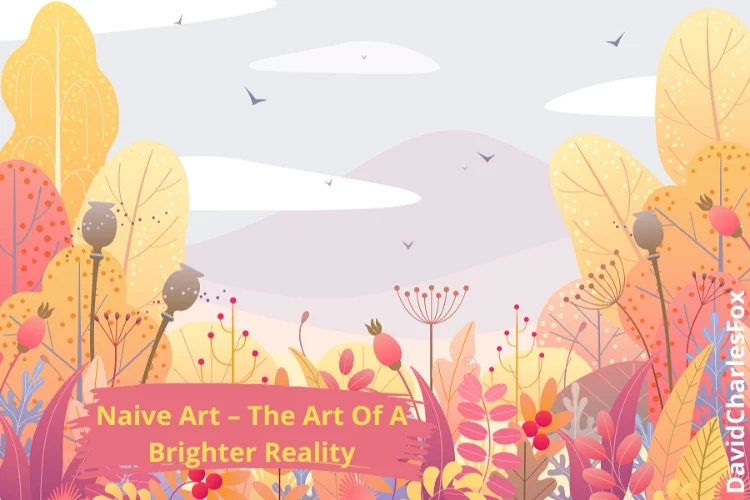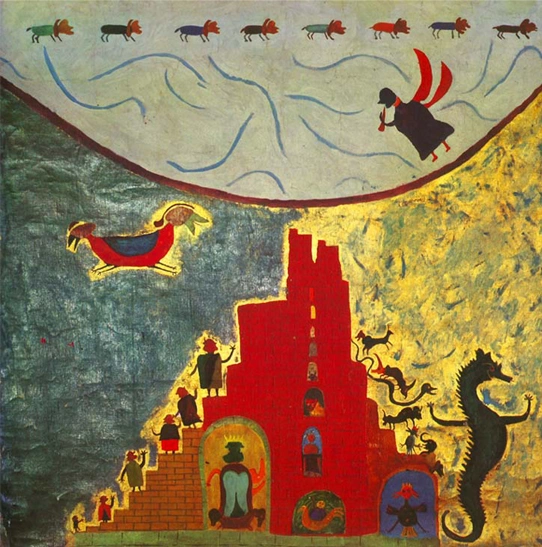Naive Art – The Art Of A Brighter Reality
by David Fox
There is a colorful world filled with fabulous details, where everything seems peacefully flying and takes a person back to his childhood, evoking coziest memories. That's the world of naive art.

Term naive refers to something that lacks experience, judgment or wisdom, something natural and unaffected, innocent.
In art, it doesn't change the meaning. Naive art includes almost all of these. Naive artists have no relevant education, they paint without any awareness of anatomy, technique or perspective, and their paintings are simple, vivid, childlike - innocent.
Naive art is any form of visual art created by individuals who lack or reject conventional education and guidance that professional artists receive. It disagrees with dominant trends in art of their time.
These artists shouldn't be confused with "Sunday artists", who paint for fun. Also, it's wrong to take naive artists for those who don't know what they're doing. They create with the same passion as educated and well-trained artists, just without formal knowledge of methods.
Contents
- Beginnings and Henri Rousseau
- Characteristics of Naive Art
- How Do Artists Create Naive Art, and What Are the Benefits of This Type of Artwork?
- Naive Artists
- Top Naive Artists
- Connection to other art genres
- What Are Some Famous Examples of Naive Art, and Why Do They Stand Out to Us?
- Are There Any Criticisms of Naive Art, and if So, What Are They?
- How Can We Experience Naive Art in Our Own Lives, and What Does It Teach Us About the World Around Us?
- Tips To Create Naive Art of Your Own
Beginnings and Henri Rousseau
It is hard to determine when and where this genre exactly originate. End of the 19th and beginning of the 20th century is the time when this genre started getting more attention and appreciation.
The 20th century was a century of experimentation when traditional ways of expression were left aside and artists were experimenting with new ways of seeing the world and were representing it in an original way.

In that time naive art was discovered. The main figure in naive art was French painter Henri Rousseau, who was discovered by Pablo Picasso.
Henri Rousseau (1844-1910), retired toll and tax collector (that's why he got a nickname Le Douanier - the customs officer), started painting as a middle-aged man and was self-taught.
He had been exhibiting since 1886, but nobody gave value to his work.
The first person who really paid attention to his work was young Pablo Picasso. He was amazed by Rousseau and considered him a true brilliance.
Rousseau's works are the most frequently reproduced examples of naive art. He was painting portraits, exotic vegetation and jungle scenes, although he had never left France or visited a jungle.
He found his inspiration in children's books and the botanical gardens of Paris. The magical world of his paintings doesn't need any explanation (nor is it possible) in order to be understandable, to speak to the audience.
Maybe precisely because of that, its magic becomes so real.
In his works was finally gained a frank virtue of emotion that Gauguin was trying so hard to achieve. Picasso and his friends considered him as the father of 20th-century painting.
Rousseau influenced many avant-garde painters, including Picasso, Jean Hugo, Surrealists and others. They adopted the artist's sense of freedom and instinctive approach to the composition.

Characteristics of Naive Art
Colorful, childlike simplicity and frankness are words that best describe paintings of naive art.

This genre turns the reality of adulthood into weightless joys of youth. It creates an altered, lighter reality. This is reached in different ways.
Often, there is an inconvenient relationship with the formal standard of painting. For example, artists ignore three rules of perspective which say that the size of objects must decrease proportionally with distance, the colour must be muted with distance and precision of details decrease with distance.
Breaking the rules is essentially what naive artist does, probably unconsciously, producing works that are geometrically inaccurate with crooked perspective and uneven shapes, as a result.
Also, details appear equally rich, no matter if they are in foreground or background. This makes an illusion that figures are floating or positioned in space without anything solid anchoring them in place.
The absence of perspective is one of the most important characteristics of naive art. Paintings convey a sense of frozen motion and deep, calm space, which contributes the feel that objects are floating.
Naive painters use beautiful, vivid, saturated colors that aren't matching reality, rather than subtle mixtures, tones and shades.
Figures in paintings are usually shown full face or absolutely strict profile. They rarely cover up much of a face and almost never paint figures entirely from the back.
Intensity and passion are communicated through the figures, especially their staring eyes and preciseness of line and color.
Details are remarkably well-defined, which, besides bright colors, adds to the liveliness of a painting.

Most common motifs are live creatures, people and flora, nature, folklore motifs, and lives of ordinary people, especially rustic scenes.
The focus is on lively characters and rarely on lifeless objects. They paint exotic places, even if they've never been there (for example Rousseau's jungle), fantastic creatures, wild animals, everyday-life scenes, rural life scenes (farmers, mowing the fields, shepherds, pets etc.), landscapes, landscapes under snow, sledding and much more.
How Do Artists Create Naive Art, and What Are the Benefits of This Type of Artwork?
As defined by art historian Sir Herbert Read, naive art is "art created by untutored artists who lack the formal training and skills that are typically acquired through art school or artistic apprenticeship." Naive artists are often thought to have a childlike innocence and purity in their work, as they aren't influenced by the trends or rules of the art world. This type of artwork can be incredibly powerful and moving, as it allows viewers to connect with the artist's emotions and experiences in a very raw and personal way.
There are many benefits to creating naive art. For one, it can be a very therapeutic process for the artist. As they aren't bound by anyrules or expectations, they can freely express themselves however they wish. This can be a great way to explore one's emotions and release any pent-up feelings. Additionally, naive art can be very charming and visually appealing. Due to the lack of formal training, naive artists often have a unique perspective that can result in some truly original and beautiful artwork.
If you're interested in creating some naive art of your own, there are a few things you'll need to keep in mind. First, it's important to let go of any preconceived notions about what art should look like. Remember that there are no rules when it comes to creating naive art - you can let your imagination run wild! Secondly, don't be afraid to experiment with different mediums and techniques. You may be surprised at what you can create with a little bit of trial and error. Lastly, be sure to focus on the process rather than the end result. Naive art is all about enjoying the journey and exploring your creativity - so have fun and see where your artwork takes you!
Naive Artists
Rousseau is undoubtedly the most influential naive artist, but there are other artists of this genre who are worth mentioning.
Antonio Ligabue, an Italian painter, was one of the most important naive artists of the 20th century. He gained recognition for his work during the 1940s.
Russian painter Nikifor created over 40 000 paintings. Sidney Nolan created landscapes that aimed to celebrate Australian history. Grandma Moses started her artistic career at the age of 78 and was known for her take on American realism.
Serbian painters from Kovačica (most famous is Zuzana Halupova) create great panoramic paintings.
Ilija Bašičević Bosilj, outsider and naive painter, uneducated Serbian farmer, started painting as a middle-aged man, and despite that had solo exhibitions even in New York.

Top Naive Artists
The world of art is filled with many different styles and genres, making it difficult to choose just one artist as the best. However, there are those artists who stand out from the rest for their unbridled creativity and originality. Here are five of the best naive artists working today.
1. Birtley Barnard
Barnard is a self-taught artist who only began painting in her early twenties. Since then, she has developed her own unique style that is characterized by its bold use of color and childlike sense of wonder. Barnard's paintings often depict scenes from her native England, as well as other parts of the world she has visited.
2. Kim Rahbek
Rahbek is a Danish artist who is best known for her large-scale paintings of animals. She often uses bright colors and simple shapes to create her pieces, which have a playful quality about them. Rahbek has said that she is inspired by the work of early twentieth-century artists such as Henri Matisse and Pablo Picasso.
3. Kelley Johnson
Johnson is an American artist who specializes in creating colorful abstractions. Her work is often compared to that of Wassily Kandinsky, as it features similar geometric shapes and bold use of color. Johnson's paintings are meant to evoke feelings of joy and happiness in those who view them.
4. Katsutoshi Yuasa
Yuasa is a Japanese artist whose paintings are characterized by their dreamlike quality. He often uses muted colors and soft lines to create an ethereal atmosphere in his work. Yuasa has said that he is inspired by the work of other Japanese artists, such as Hiroshige and Hokusai.
5. Maria Sibylla Merian
Merian was a German artist who is best known for her detailed paintings of insects and plants. She was one of the first naturalists to document the metamorphosis of caterpillars into butterflies. Merian's work was greatly influential on future generations of artists, including Georges Cuvier and Charles Darwin.
Connection to other art genres
Naive art is often connected to primitivism, primitive (tribal) art, and confused with folk and outsider art.
Primitive art refers to tribal art from Africa, the South Pacific and Indonesia, prehistoric and very early European art. Primitivism is used to describe any art that imitates or is characterized by primitive art.
Folk art is utilitarian and decorative art that expresses national identity. Usually, folk artists are uneducated, as well as naive artists. It's obvious why folk and naive art easily confused.
Outsider art represents any work of art that is created by socially and culturally marginal people - undereducated, mentally ill, prisoners - unconnected to the conventional art world.

Appreciation of naive art has increased over years. Today, it is completely recognized art genre that is spread and represented in galleries all over the world.
What Are Some Famous Examples of Naive Art, and Why Do They Stand Out to Us?
Some famous examples of naive art include the paintings of Grandma Moses and Henri Rousseau. These artists' works are often characterized by their simple, childlike style and lack of formal training. While their work may not be as technically polished as that of more traditional artists, it often has a certain charm and innocence that speaks to viewers.
Naive art can be found in many different cultures around the world. It is sometimes called "folk art" or "outsider art," as it is typically created by people who do not consider themselves professional artists. Naive artists often have a unique perspective on the world, which is reflected in their artwork.
Grandma Moses is one of the most famous naive artists. She was born in 1860 in New York State and did not begin painting until she was in her 70s. Her works depict rural life in America during the early 20th century. Moses' paintings are known for their simple style and lack of perspective.
Henri Rousseau is another well-known naive artist. He was born in France in 1844 and began painting later in life, after retiring from his job as a tax collector. Rousseau's work is often categorized as Surrealist, due to its sometimes dreamlike quality. His paintings frequently feature jungle scenes, with animals that appear to be drawn from Rousseau's imagination.
While naive art may not be as technically proficient as traditional art, it can still be very beautiful and moving. The artworks of Grandma Moses and Henri Rousseau are two examples of this. Naive artists often have a special way of seeing the world, which is reflected in their artwork.
Are There Any Criticisms of Naive Art, and if So, What Are They?
Naive art has often been criticized for being too simple or childlike. Some critics have also said that it lacks sophistication and refinement. However, others argue that these very qualities are what make naive art so special and appealing. Ultimately, it is up to each individual to decide whether or not they enjoy this type of art.
How Can We Experience Naive Art in Our Own Lives, and What Does It Teach Us About the World Around Us?
Naive art is a type of art that is characterized by its childlike simplicity and lack of sophistication. Naive artists are often not formally trained in art, and their work tends to be spontaneous and expressive. Naive art can be found in many different mediums, including painting, sculpture, photography, and even music.
While naive art may seem like a new phenomenon, it actually has a long history. Some of the earliest examples of naive art date back to the late 18th century, when European artists began to explore folksy, rustic styles of painting. In the 19th century, naïve art became increasingly popular in France and other parts of Europe. By the early 20th century, naive artists had begun to emerge in the United States as well.
One of the most famous naive artists was Henri Rousseau, a French painter who began painting later in life and was self-taught. Rousseau's work is characterized by its flat, two-dimensional style and dreamlike quality. His best-known painting, "The Dream," shows a woman reclining on a couch in a jungle setting, surrounded by plants and animals.
Rousseau's work was initially met with ridicule by the art establishment, but he eventually gained recognition as an important artist. His work influenced other artists, including Pablo Picasso and Georges Braque, who helped pioneer the Cubist movement.
While Rousseau is one of the most famous naive artists, there are many other talented naïve painters working today. Naive art has experienced a resurgence in popularity in recent years, as more people have become interested in its simple beauty and childlike innocence.
If you're interested in experiencing naive art in your own life, there are a few ways to go about it.
- One option is to visit a local gallery or museum that specializes in naïve art. Many major cities have at least one gallery that features this type of work.
- Another option is to seek out naïve artists who sell their work online or at craft fairs. This can be a great way to support local artists and get your hands on some truly unique pieces.
- Finally, you can try your hand at creating naïve art yourself! This can be a fun and rewarding experience, whether you're an experienced artist or a complete beginner.
Tips To Create Naive Art of Your Own
There are a few things to keep in mind if you want to create naive art of your own. First, it's important to relax and let your imagination run wild. Naive art is all about spontaneity and expressiveness, so don't worry about getting everything "right."
Second, pay attention to your surroundings and let them inspire you. Sometimes the simplest objects can make for the most interesting paintings or sculptures.
And finally, have fun! Creating art should be enjoyable, so don't take yourself too seriously.
Whether you're a seasoned artist or a complete novice, we hope this article has inspired you to check out naive art for yourself. It's a beautiful and unique form of expression that can teach us a lot about the world around us.

About David Fox
David Fox is an artist who created davidcharlesfox.com to talk about art and creativity. He loves to write, paint, and take pictures. David is also a big fan of spending time with his family and friends.
Leave a Reply
 |
 |
 |
 |
Just Art and Fun
Now get FREE Gifts. Or latest Free phones here.
Disable Ad block to reveal all the secrets. Once done, hit a button below
 |
 |
 |
 |